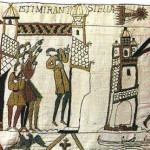Embroidered, Not Woven
One of the most amazing pieces of medieval artwork is the Bayeux Tapestry (actually, it’s an embroidery). It is a hand-stitched (tapestries are woven) account of the Battle of Hastings and the events leading up to the battle.
Most accounts date the origin of the Bayeux Tapestry to either right after or several decades after the battle. The fact that something as fragile and vulnerable as this tapestry has survived almost a thousand years is quite incredible.

Halley’s Comet-Honorable Mention
The tapestry is approximately 224 feet long made up of sections beginning with the meeting of King Edward the Confessor and Earl Harold Godwin. Only 15 individuals are actually mentioned in the tapestry. Only five women are depicted. Including the women, there are a total of 626 humans stitched onto the tapestry, not to mention the horses, buildings, ships, and other interesting items (including Halley’s Comet).
Most people look at the tapestry as a tribute to the Norman victory on 14 October 1066 (i.e., from the French perspective). However, Andrew Bridgeford, in his fascinating book, 1066: The Hidden History in the Bayeux Tapestry, makes a strong case that the tapestry was the work of the English and the tapestry tells a much different story than originally thought.
The standard interpretation is that Edward sent Harold to Normandy to confirm Edward’s wish that Duke William will succeed Edward as king of England. Now I’m no historian by any means but as Mr. Bridgeford interprets each scene, he convinced me that Harold went on his own for the purpose of trying to obtain the release of his brother (Wulfnoth) and his nephew (Hakon): both were prisoners of Duke William.

Mr. Bridgeford makes the argument that Edward had long ago dismissed Duke William as his successor. On his deathbed, Edward told Harold that he would be king. For the English in those days, whatever is said or promised on the deathbed supersedes any other promises or wishes. However, in France, that was not the case. Harold in fact, swore an oath to Duke William that he would support William’s cause to be king of England (all of this is portrayed in the tapestry). William argues that Harold’s oath supersedes any other promises.
So we have the start of a conflict that would only be resolved with the invasion of England by William and the conquest of the English.
Do we have a lot of stories? Of course we do. I’m looking forward to sharing these with you. Please continue to visit our newsletter and blog. Perhaps you’d like to subscribe so that you don’t miss out on the most recent newsletter and blog posts.
Thanks so much for following my newsletter and blogs as well as my little journey through this incredibly interesting process of writing a series of niche historical walking tour books.
-Stew
Please note that I do not and will not take compensation from individuals or companies I mention or promote in my blog.
Are you following us on Facebook and Twitter?
Copyright © 2014 Stew Ross

